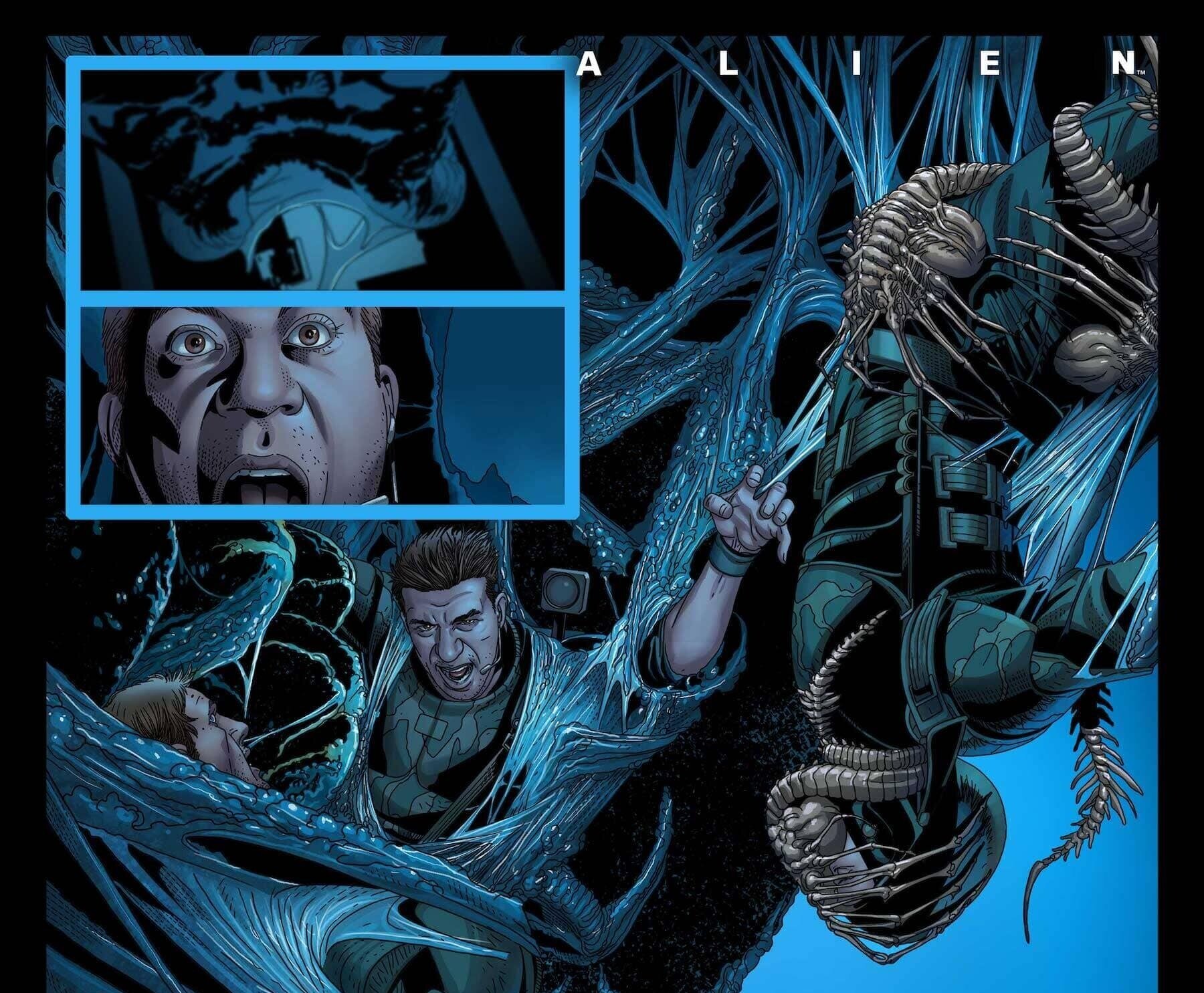Review: ALIEN #1 (Marvel Comics)
Marvel’s Opening Alien Salvo Is a Breath of Fresh Air
by Patrick Greene
Art by Salvador Larroca and Guru-eFX
It’s hard to overstate how significant Alien #1 is; no matter how you look at it, it represents something big.
In terms of comics, this is the first official non-Dark Horse Alien book in this format since Archie Goodwin and Walt Simonson’s Alien: The Illustrated Story in 1979.
In terms of the film industry, this is the first tangible product of Disney’s acquisition of the Alien IP (which became official in March of 2019).
And in terms of fandom, this is a huge step into a new future. A future without 20th Century Fox, without Dark Horse, without Ripley—without a lot of the things we think of when we think “Alien.”
But for all the big things this represents, at the end of the day it’s also something quite small: a single issue of a new comic series, featuring xenomorphs and facehuggers and Weyland-Yutani. A story that feels familiar and yet distinctly new. A story, we’re told in the opening panels, about darkness.
Any good comic writer knows you don’t get a second chance at a first issue. It’s an opportunity to say “this is what these characters are about, to me.” And with writer/Alien superfan (seriously, check out his recent PO interview) Phillip Kennedy Johnson at the helm, we find out early on that darkness—the kind of darkness beyond the absence of light, the sort of darkness we sometimes feel tugging at the edges of a nightmare—is key to this new series.
Johnson, who is also writing Superman and Action Comics at DC, introduces us to a new lead character: Gabriel Cruz, retiring Security Chief of a Weyland-Yutani installation called Epsilon Station. We get glimpses into Cruz’s past—time in the Marines, flashes of hive sequences, therapy sessions—but much of Alien #1 is spent in an unusually familiar present. A present that includes retirement parties, swanky Earth neighborhoods, father/son tension, and reminiscences about grocery stores.
It’s not our actual present-day, of course: Johnson’s story is set in 2200. Twenty-one years after Hadley’s Hope and Ripley’s death, and seventy-eight years after the events onboard Nostromo. Cruz, a middle-aged retiree, was almost certainly in the Colonial Marines during the events that unfolded during Aliens. We see a photo of his platoon with a Bishop model. We get a sense of lived history without being told much.
We knew going in (from our conversations with Phillip Kennedy Johnson as well as periodic teases from Marvel) that this was going to be a story “inside” Weyland-Yutani—inside the megacorp pulling the strings of the Alien saga like a ghastly puppeteer from the very beginning. I cracked open this issue expecting some sort of industrial espionage (a la the latter Brian Woods Dark Horse series) with a clear-cut hero to fight the faceless mega-villain. But what I found, instead, was something considerably more nuanced than that.
In the films, Weyland-Yutani is seen only in fleeting glimpses. Other than the board room scene in Aliens, WY is almost exclusively something talked about but never actually seen. For most of us, other than the brief debriefing sequence in Aliens, our direct experience of Weyland-Yutani has been mostly through masked commandos at the end of Alien 3, deleted Hadley’s Hope material restored in the Special Edition of Aliens, or lines of green text on a black screen in Alien.
Art by Salvador Larroca and Guru-eFX
But in this first issue, we see something different: humans. We see that Weyland-Yutani is a massive employer of thousands, if not millions, of people. People with dreams, aspirations, personal lives. People who can’t wait to get home to see their families. The corporation perpetrates acts of terrible evil—but don’t the corporations we interact with every day in our world do the same things, in different ways? Look at Nestle. Look at Monsanto.
What’s more, our protagonist—or at least the character with the most page-time—is a Weyland-Yutani pro so good at his job they say there will be a wing of Epsilon Station named in his honor after he’s gone. An absentee father, dealing with a mysterious illness, waking up with nightmares and visions of strange shapes.
And the characters fighting Weyland-Yutani—the characters every single Alien fan will start the issue rooting for—are quickly shown to be more problematic than we initially think. More violent. Not idealized crusaders against a faceless evil; people with guns and zip ties, dehumanizing their enemy by constantly reminding themselves that they’re “the good guys.”
Many of you will know Salvador Larroca through his majestic work on Marvel’s Doctor Doom series, which I HIGHLY recommend. Larroca is a terrific visual storyteller. There are glimpses of this talent in Alien #1, but on the whole I want the art to be edgier. To be pushed a little. For Larroca to let loose and scare us. The art in this issue is very good—and completely on par with what most fans will expect—but knowing what Larroca is capable of, I feel he’s holding back a little here. The colors, by Guru-eFX, are stunning and every bit the polished Marvel product any comic reader will recognize. Again, maybe a little too polished for my liking—a little too vibrant, a little too perfect—but maybe that’s just something I need to get used to.
Nothing about Alien #1 is simple. It’s a story I truly encourage you to read twice before coming to a conclusion on whether or not you’re onboard with this new Marvel series. It isn’t what you are expecting.
And that’s exactly why it’s so necessary.
Score: 8/10


